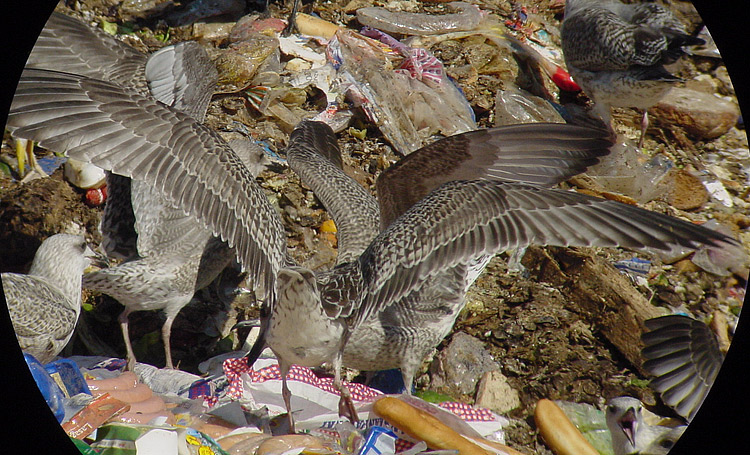 Herring Gull- Zilvermeeuw (argentatus & argenteus)
Herring Gull- Zilvermeeuw (argentatus & argenteus)
(last update: December 15, 2011
Herring Gull 1cy (argentatus), August 06 2002, Tampere, Finland (61.31N,23.43E).
A 1cy argentatus, showing the window on the inner primaries.
Argentatus in juvenile plumage has the head and under-parts streaked grey-brown, rather pale on forehead and throat and with dark ear-coverts. The mantle and scapulars are brown based with buffish-yellowish fringes when the feathers are fresh, with shiny white fringes when the feathers are older. The notched pattern is repeated on the lesser, lower lesser and median coverts, although the medians have paler centres. The greater coverts show a 'piano-key' pattern; also on the outer greater coverts in argenteus, but sometimes these outer greater coverts have extensive dark centres and a thin fringe in argentatus.
The tertials have an obvious notched pale fringe and transversal bar, although some argentatus have a pattern much similar to michahellis, with only a very narrow straight white fringe and an extensive dark brown centre.
The secondaries, primaries and primary coverts are dark with a small white tip (obvious on some birds), but the inner primaries show a pale window, prominent from below and above. The under-wing is rather uniform grey-brown patterned. The tail has a broad sub-terminal band and isolated dark bars on the basal half. Some argentatus have a broken tail-band similar to 1cy marinus, with deep notching. The iris is dark, the bill is blackish, sometimes with a paler base, and the legs are flesh-pink.
The partial autumn moult (moult into so-called "first winter" plumage) includes the body and head feathers. This moult may start as soon as the nest is abandoned. Due to the wide breeding range of argentatus in Scandinavia, from Denmark to the far north of Norway and Russia, much variation exists regarding the commencement of this partial moult. We did a small survey in Tampere, SW Finland in the second week of August. The results are presented in the table below. Over 50% of the 1cy argentatus started scapular moult and about 1/3 of the birds showed second generation scapulars. However, with severe winter conditions in northern Scandinavia, 2cy argentatus may turn up along the coast of the Netherlands, still in complete juvenile plumage by January. These birds are believed to origin from the far northern Scandinavian and Russian populations.
In the partial moult, the upper breast and head turns paler on throat and forehead. The feathers on belly and vent will still be juvenile in most 1cy argentatus by November. From August onwards, the mantle and upper scapulars are moulted to second generation feathers, showing an anchor pattern and a dark base. The lowest row of scapulars will be still juvenile by April in most 2cy birds (contra e.g. michahellis). The juvenile wing-coverts, rectrices and remiges start to bleach and show wear in the fringes from September onwards in the southern populations.
In the table below, the scapular moult scores of 1cy August argentatus in Finland can be read:
| 1cy argentatus in August, Tampere landfill, Finland, August 10 2002, 10:00-12:00 h. | |
| total : | |
| all scaps juvenile | 50 (41%) incl orange C211J |
| some scaps missing | 35 (29%) |
| 1-5 scaps new | 13 (11%) |
| 6-10 scaps new | 13 (11%) |
| 11+ scaps new | 10 (8%) |
| total sample size, n: 121. | |
